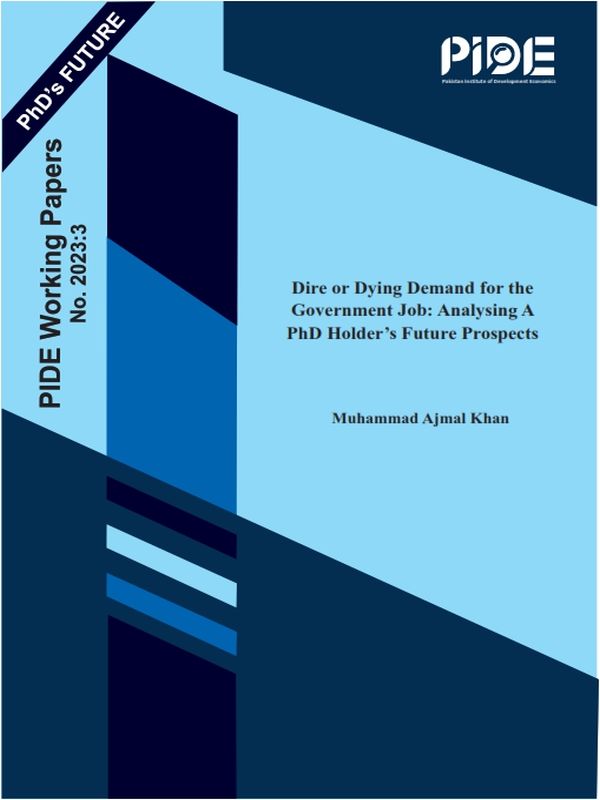Dire or Dying Demand for the Government Job: Analysing A PhD Holder’s Future Prospects
1. INTRODUCTION
Higher Education (HE) is continuously changing globally (Altbach, 2008). The demand for a knowledge-based economy has forced the HE system towards drastic structural transformation to supply well-qualified human capital (Welch, 2011). The structural transformation is the outcome of external and internal pressures of the twenty first century (Altbach & Peterson, 2007). Similarly, (Qadir, 2011) noticed that the transformation of Pakistani HE in 2002 was an upshot of external influence and internal responses. Thus, the government established the HEC (Higher Education Commission) in 2002. It further replaced the University Grants Commission UGC with HEC (HEC Ordinance 455, 2002).
In the early twenty-first century, different initiatives have been introduced in Pakistani HE in general and universities in particular. The reforms were designed to bring changes in different areas, including academic capacity building and restoration of Research and Development (R&D) (Osama, et al. 2009). Moreover, the resources and energy were devoted to ramping up the human capital formation to promote the R&D capacity of academic and non-academic institutions, with around 13,000 doctoral scholarships provided between 2003-2011. Previously around 300 scholarships were provided (Rehman, 2009).
The HEC is still knuckling down on augmenting the number of doctoral degree holders in the country. According to a recent HEC report (HEC, 2021), 145 scholars went abroad for PhD studies, 33 scholars were partially supported to complete their studies abroad, 179 scholars completed their doctorates, 273 PhD scholars proceeded abroad under International Research Support Initiative Programme (IRSIP), and 32 scholars proceeded abroad to join post-doctoral research. Additionally, under the indigenous PhD fellowship program, 218 candidates joined PhD studies, with around 473 potential candidates completing their PhD.
As for the expansion of Higher Education Institutes (HEIs), the number of universities has increased dramatically. At independence, Punjab University was the only public university; the expansion occurred during Zulfiqar Ali Bhutto’s tenure. Around a decade ago, there were 87 universities in Pakistan (Hoodbhoy, 2009). Currently, there are 243 universities; 144 are public universities, while 93 belong to the private sector (Higher Education Statistics, 2022). Despite the large number of HEIs, the size of doctoral degree holders’ faculty is very circumscribed. We have insufficient PhDs and professors in HEIs. In HEIs, on average, 31 percent are PhDs, and 70 percent are non-PhD holders. Gender-wise, the distribution is skewed towards males, with 23.4 percent of males and only 7.4 percent of females holding PhD degrees (HEC, 2017). Similarly, Pakistani universities have insufficient professors (Haque & Khan, 2021).
Unfortunately, the outcome of these strategies and policies has led to unemployed, under-employed and post-graduates in the country. Nayab (2011) showed that the unemployment rate is prominent among the youth (new entrants in the labour force). A Haque & Nayab (2022) study indicates that getting a job takes a decade or even more. Moreover, the study reveals that 31 percent of youth with professional and nonprofessional degrees are unemployed. More importantly, the HEC (HEC, 2022) has recently endorsed that more than 4000 PhD scholars are jobless in Pakistan. Thus the questions are, do we need such a large number of PhDs? Are there enough opportunities for youth and skilled human resources? Are we efficiently utilising our scarce resources? Do we consider the supply and demand dynamics for PhD holders? Do we conduct a cost-benefit analysis before making policies? Is there a quantity and quality trade-off? All these questions need to be addressed empirically.
Therefore, this study is designed to; investigate the current status of local and international post-graduate doctoral degree holders. To examine how the current status changes with the demographic characteristics. Furthermore, to study the prospects of PhD holders using the data collected by the PhD Doctors Association Pakistan (PDA) for the year 2020.




